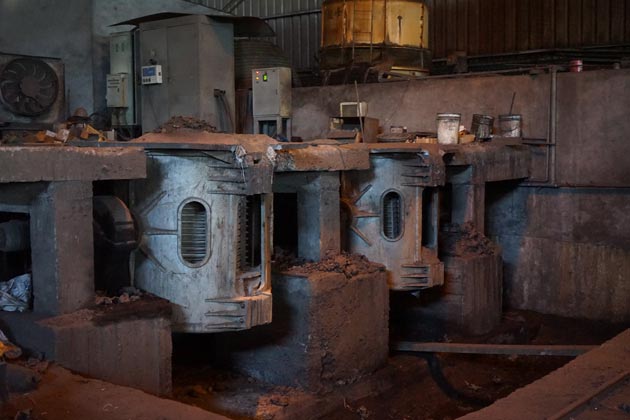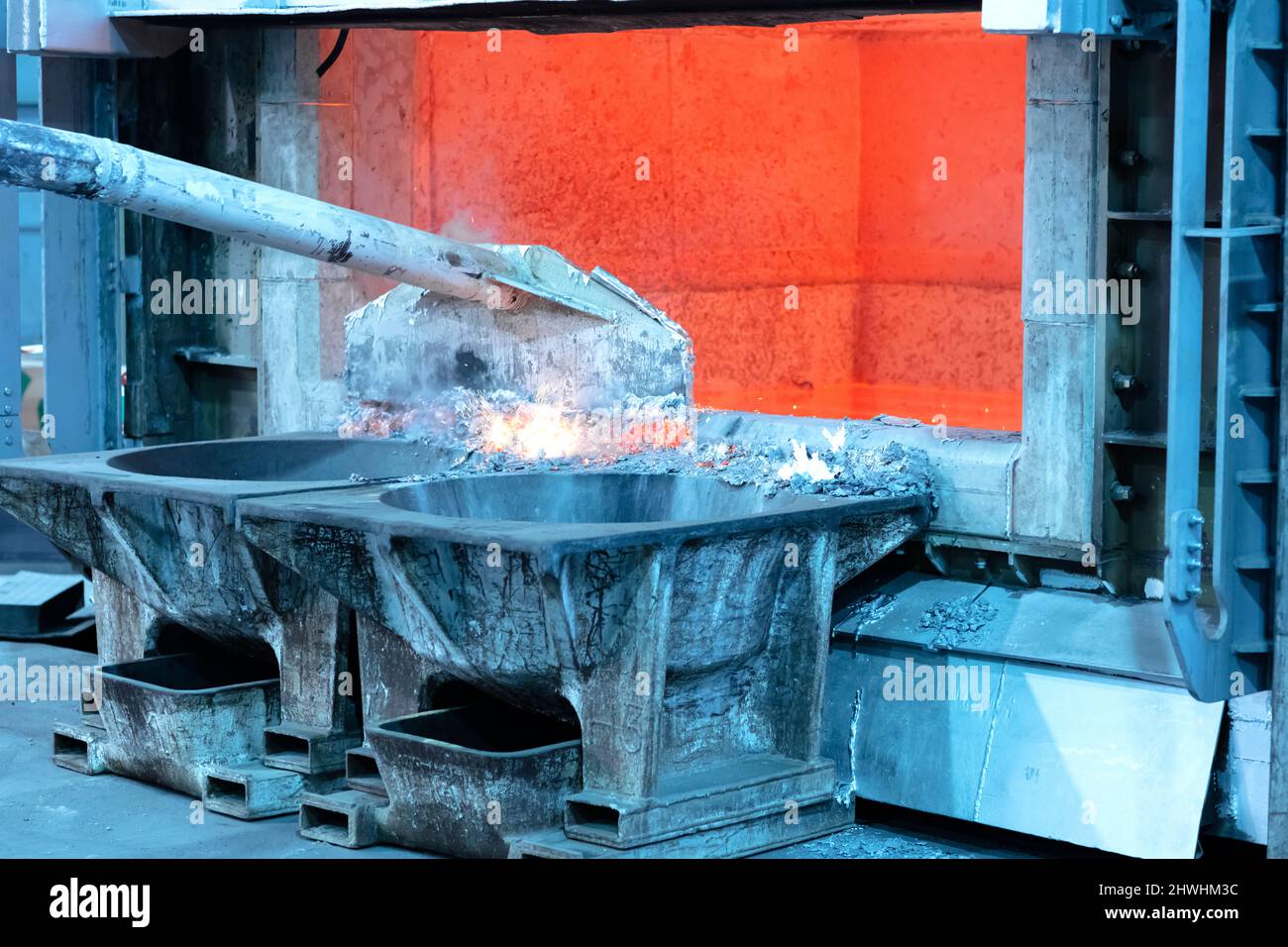How Aluminum Foundry Wisconsin still be relevant in casting
Recognizing the Conveniences and Innovations in the Aluminum Foundry Industry
The Aluminum Foundry market plays an essential duty in contemporary manufacturing. Its light-weight residential or commercial properties notably boost gas effectiveness, particularly in auto and aerospace sectors. In enhancement, Aluminum's resistance to corrosion guarantees longevity in numerous applications. As the sector develops, innovations such as innovative recycling and additive manufacturing are reshaping production techniques. Exploring these improvements exposes not just the benefits but likewise the difficulties in advance for Aluminum foundries in a rapidly transforming market.
The Lightweight Benefit of Aluminum
Aluminum's lightweight nature offers substantial advantages across different markets, particularly in production and transport. Its low density permits the production of elements that are much easier to manage and mount, resulting in lowered labor prices and improved performance. In the automotive sector, lighter vehicles add to enhanced fuel economy and reduced discharges, aligning with international sustainability objectives. In aerospace, the usage of Aluminum lowers the general weight of aircraft, which is critical for improving efficiency and lowering operational prices.
Furthermore, Aluminum's light-weight residential properties facilitate cutting-edge layouts that were formerly unfeasible with much heavier materials. This versatility makes it possible for producers to create intricate shapes and structures while maintaining architectural integrity. Generally, the light-weight advantage of Aluminum not just enhances product efficiency however additionally drives improvements in technology and style, making it a preferred product in numerous applications.
Corrosion Resistance and Longevity
The Aluminum Foundry sector is renowned for producing products with superior rust resistance, making them suitable for different applications. This building, incorporated with improved structural honesty, contributes to the lasting efficiency advantages that Aluminum elements provide. Because of this, markets progressively depend on Aluminum to satisfy requiring environmental conditions without compromising top quality.
Superior Deterioration Resistance
While different metals face substantial difficulties from ecological factors, Aluminum sticks out for its superior deterioration resistance, making it a favored choice in many applications. This residential or commercial property is mainly due to a natural oxide layer that bases on the Aluminum surface, offering an obstacle versus dampness and corrosive representatives. Unlike various other steels that might corrosion or degrade in time, Aluminum keeps its integrity also in extreme settings, such as seaside areas or industrial setups. Furthermore, its light-weight nature incorporated with rust resistance makes it optimal for applications in aerospace, automotive, and marine sectors. Generally, Aluminum's remarkable durability not only improves item longevity yet additionally lowers upkeep prices, providing a compelling benefit for customers and makers alike.
Improved Structural Stability
Engineers and developers progressively identify the value of enhanced structural stability in modern applications, where both rust resistance and longevity are important. Aluminum alloys, understood for their lightweight properties, additionally display outstanding resistance to corrosion, making them appropriate for harsh settings. The innovative techniques utilized in the Aluminum Foundry industry contribute significantly to generating parts with boosted durability. Advanced casting processes and alloy structures are customized to satisfy details efficiency requirements, making certain that structures can endure extreme conditions without endangering integrity. Surface area treatments and layers improve the life expectancy of Aluminum products, further reducing damage over time. This focus on enhanced architectural integrity not just extends the use of materials however likewise minimizes upkeep expenses, solidifying Aluminum's placement as a product of selection in different sectors.
Resilient Performance Benefits
Durable performance in Aluminum components is largely credited to their premium rust resistance and durability. Unlike many steels, Aluminum normally creates a safety oxide layer, which stops corrosion and wear and tear in different atmospheres, including industrial and marine settings. This fundamental residential property considerably prolongs the life-span of Aluminum products, reducing upkeep and substitute expenses. In enhancement, the light-weight nature of Aluminum enhances its applicability throughout sectors without jeopardizing toughness. The material's resistance to damage likewise adds to its integrity popular applications, making it an optimal option for auto, aerospace, and building and construction sectors. As industries progressively focus on sustainability and long life, Aluminum's efficiency benefits align with modern-day engineering requirements, solidifying its duty in cutting-edge production processes.
Ecological Impact and Sustainability
 As the Aluminum Foundry sector progresses, it progressively prioritizes ecological effect and sustainability, identifying the demand for accountable techniques in the face of environment change. Initiatives to minimize waste and power intake go to the forefront, with many factories embracing reusing campaigns to reclaim Aluminum scrap. This not only minimizes raw material use however additionally notably cuts down power expense, as recycled Aluminum calls for just a fraction of the energy contrasted to key production.
As the Aluminum Foundry sector progresses, it progressively prioritizes ecological effect and sustainability, identifying the demand for accountable techniques in the face of environment change. Initiatives to minimize waste and power intake go to the forefront, with many factories embracing reusing campaigns to reclaim Aluminum scrap. This not only minimizes raw material use however additionally notably cuts down power expense, as recycled Aluminum calls for just a fraction of the energy contrasted to key production.Additionally, innovations in emissions regulate modern technologies are being applied to decrease air contaminants, straightening procedures with more stringent environmental guidelines. Foundries are likewise discovering different power resources, such as solar and wind, to power their facilities sustainably. By cultivating partnership with stakeholders, the sector intends to develop ingenious solutions that enhance environmental stewardship. Jointly, these efforts highlight a commitment to minimizing the Aluminum Foundry's carbon impact while use this link promoting a round economic climate within the manufacturing field.
Advanced Manufacturing Techniques
 Reinventing production procedures, the Aluminum Foundry sector is increasingly incorporating innovative production techniques to boost effectiveness and precision. Techniques such as computer numerical control (CNC) machining and additive manufacturing have actually arised as crucial components in enhancing manufacturing operations. CNC machining enables high-precision component manufacture, substantially lowering material waste and manufacturing time. Additive production opens brand-new opportunities for intricate geometries and light-weight layouts that were previously challenging to achieve.
Reinventing production procedures, the Aluminum Foundry sector is increasingly incorporating innovative production techniques to boost effectiveness and precision. Techniques such as computer numerical control (CNC) machining and additive manufacturing have actually arised as crucial components in enhancing manufacturing operations. CNC machining enables high-precision component manufacture, substantially lowering material waste and manufacturing time. Additive production opens brand-new opportunities for intricate geometries and light-weight layouts that were previously challenging to achieve.In addition, the implementation of automation and robotics in Aluminum foundries simplifies procedures, reduces human mistake, and improves worker security. These innovations help with a more receptive production environment, making it possible for makers to adapt quickly to market demands. The integration of innovative simulation software better improves the layout and screening stages, causing remarkable product quality. Collectively, these strategies not just boost operational efficiency however also foster innovation, placing the Aluminum Foundry market at the center of modern-day manufacturing.
Innovations in Recycling Processes
The Aluminum Foundry industry is not just progressing in making techniques yet is additionally making considerable strides in reusing procedures. Developments are arising to boost the efficiency of recycling methods, lowering energy usage and enhancing sustainability. Advanced sorting innovations, such as automated optical sorting, make it possible for the identification and separation of Aluminum from various other materials with high accuracy. This causes a better of recycled Aluminum, which is crucial for keeping the integrity of the end products.
Moreover, closed-loop recycling systems are being applied, allowing makers to recycle Aluminum scrap within their very own production processes. This reduces waste and promotes a circular economic situation. In addition, research right into brand-new recycling methods, such as hydrometallurgical processes, provides the potential for recovering Aluminum from complicated waste streams. These innovations not only add to decreasing the carbon impact of the Aluminum Foundry sector yet also bolster its financial viability in a progressively eco mindful market.
Applications Throughout Numerous Industries
Countless sectors are increasingly acknowledging the adaptability and benefits of Aluminum Foundry products, causing widespread applications throughout industries such as vehicle, building, consumer, and aerospace products. In the automotive sector, Aluminum spreadings add to light-weight automobile layouts, boosting gas efficiency and efficiency. Aerospace producers utilize Aluminum parts for their strength-to-weight ratio, necessary for airplane structures and components.
In building, Aluminum is favored for its durability and resistance to rust, making it suitable for home window structures, roof covering, and architectural supports. Durable goods also take advantage of Aluminum Foundry products, as seen in kitchenware, electronic devices, and packaging, where light-weight and recyclable products are essential.
The adaptability of Aluminum Foundry methods permits for accurate specifications and complex designs, dealing with the diverse needs of these markets. As an outcome, Aluminum Foundry items are ending up being indispensable to modern manufacturing processes throughout various industries.
Future Trends in Aluminum Foundries
As industries remain to advance, Aluminum factories are positioned to embrace numerous key fads that assure to boost efficiency and sustainability. One famous trend is the increasing adoption of electronic technologies, consisting of automation and synthetic intelligence, which simplify procedures and improve top quality control. In enhancement, the push towards sustainable techniques is leading factories to purchase recycling innovations, substantially lowering waste and energy consumption.
 Another arising fad is using innovative alloys and her explanation products, providing to the expanding demand for light-weight and long lasting components throughout various fields (Aluminum Foundry). The combination of additive production techniques is prepared for to transform component design, using personalization and lowering lead times.
Another arising fad is using innovative alloys and her explanation products, providing to the expanding demand for light-weight and long lasting components throughout various fields (Aluminum Foundry). The combination of additive production techniques is prepared for to transform component design, using personalization and lowering lead times.Collaboration with research study establishments is likewise expected to drive innovation, as shops seek to establish new processes and materials. Aluminum Foundry. Collectively, these patterns indicate a transformative future for the Aluminum Foundry market, lining up with broader goals of sustainability and efficiency
Frequently Asked Questions
What Are the Common Prices Related To Aluminum Foundry Production?
The common prices linked with Aluminum Foundry manufacturing include resources, labor, power, tools upkeep, and overhead expenditures. These elements collectively influence the general financial investment required for efficient Aluminum spreading operations.
How Does Aluminum Contrast to Various Other Steels in Toughness?
Aluminum, while lighter than several metals, shows impressive strength-to-weight proportions. Compared to steel, Aluminum is less solid yet provides exceptional rust resistance, making it a beneficial selection in applications where weight and resilience are essential.
What Precaution Remain In Area in Aluminum Foundries?
Safety steps in Aluminum shops generally include necessary individual protective tools, ventilation systems to control fumes, routine tools upkeep, training programs for employees, and adherence to strict safety and security regulations to decrease risks related to liquified metal handling.
How Is Top Quality Control Managed in Aluminum Spreading Processes?
Quality assurance in Aluminum spreading processes includes rigorous evaluations at numerous phases, including raw material evaluation, process monitoring, and end product screening. Methods such as statistical procedure control and non-destructive screening guarantee adherence to industry criteria.
What Certifications Are Necessary for Aluminum Foundry Vendors?
The significance of accreditations for Aluminum Foundry vendors includes ISO 9001 for high quality management, ISO 14001 for ecological administration, and industry-specific standards check my blog like ASTM and SAE, ensuring conformity, security, and reliability in making processes.
The Aluminum Foundry market plays an essential function in modern production. The Aluminum Foundry market is renowned for generating products with exceptional rust resistance, making them excellent for numerous applications. Transforming production processes, the Aluminum Foundry sector is progressively integrating advanced manufacturing strategies to improve effectiveness and accuracy. The Aluminum Foundry sector is not just progressing in manufacturing methods however is additionally making considerable strides in reusing procedures. As markets continue to develop, Aluminum shops are poised to accept several key trends that assure to improve performance and sustainability.